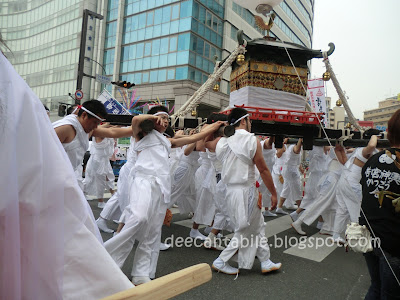With more than two million visitors every year, Dontaku is one of Japan’s biggest festivals. Originally known as “Matsubayashi”, its roots stretch back to 1179. The origins of Dontaku can be seen in the Hakata Matsubayashi parade. The three gods of fortune proceed along the street on horseback accompanied by small children. As they go, they shout “iitate”. In their wake come groups of local people known as “toorimon.” Fukurokuju, the God of long life, is easily recognized by his long mask. With him come the god Ebisu and his wife and Daikoku, the God of wealth, who wears a yellow silk shawl on his head and carries a bag. This procession of the three Gods and children has remained unchanged since the middle ages and been designated by the prefecture as an intangible cultural property.
 |
| Kazariyama, for decoration use only |
 |
| Matsubayashi People..Kakkoyokattaaaa.. |
A very deep impression I felt when one of Matsubayashi-san gives me a stick, which is it should be his property on the parade, although the events had not started yet. He said that was a “Lucky Stick”. And yes, I was lucky enough to see the procession by my own. When viewing a parade matsubayashi, some people have given me a lot " Hakata Torimon ", special cake that should exist in each parade of matsubayashi.
 |
Matsubayashi-Sama..thank you for the Lucky-Charm Stick ^^
|
 |
Hakata Torimon
|
That was truly a citizens’ festival because groups and individuals from all over Kyushu descend on Fukuoka to join these parades: local citizens' associations, schools, private companies, small businesses, marching bands and drum majorettes, all dancing freely in the street while showcasing their unique costumes and talents. The participation of Indonesia, Malaysia, Thailand, and Scotlandia add an international flavor to the festival. It is really an occasion for people from all walks of life to meet and wish each other well.
 |
| Chigo Mai, The dancer |
 |
| The Children of Matsubayashi |
 |
Genki na Obaasan.. ^^
|
This year’s festival was originally intended to commemorate the opening of the new Hakata Station building and the new Kyushu Shinkansen, but in light of recent events in the Eastern area, the theme has been changed to “Ganbarou Japan (Do not Give Up, Japan)”. There is plenty to enjoy, including performances on many different stages, sales at local shops, street stalls and more. Without doubt, though, the highlight is the colorful parade by more than 650 costumed “Dontaku teams”. As an international student, we have the opportunity to participate in the parade by wearing our traditional clothes and join with the Asia Pacific Children Convention.




















No comments:
Post a Comment